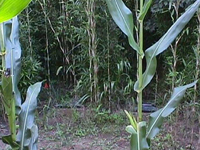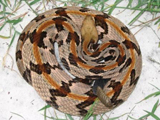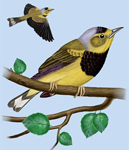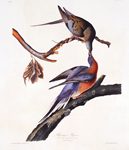Ecological Importance
Riparian Buffers
Stands of rivercane (canebrakes) have been shown to be effective riparian buffers, trapping sediments and nutrients from agricultural and other surface runoff. On-going studies at Southern Illinois University show that a mature canebrake (30 year-old) was found to reduce groundwater nitrates by 99%, reduce nutrients in surface runoff (nitrate-N, dissolved ammonium-N, total ammonium-N, and total orthophosphate masses) by 100%, and reduce sediments by 100% within a 10 m buffer. In all cases, the canebrake was a more effective buffer than the adjacent forest.
Mature canebrakes make effective riparian buffers due to their high stand density (reported culm densities of 328,003 stems ha-1), litter accumulation, and high soil  porosity. Runoff flow velocities decrease dramatically when entering a canebrake, allowing water to infiltrate the soil and sediments to deposit. The expanse of root/rhizome structure associated with mature canebrakes likely provides an effective soil stabilizer along riparian corridors as well.
porosity. Runoff flow velocities decrease dramatically when entering a canebrake, allowing water to infiltrate the soil and sediments to deposit. The expanse of root/rhizome structure associated with mature canebrakes likely provides an effective soil stabilizer along riparian corridors as well.
Wildlife Habitat
 Canebrakes also provide valuable habitat for wildlife. Historical accounts along with modern surveys identify at least 21 mammal species, 16 bird species, 4 reptile (snake) species, and >20 species of Lepidoptera are found within canebrakes, though it is likely that there are many additional species which also use canebrake habitat. Of these species, several are currently listed as threatened, endangered, or extinct. It has been suggested that the decline and/or the demise of these species may be partially due to the loss of canebrakes. Perhaps loss of canebrakes exacerbated the rarity and extinction of the Carolina parakeet, passenger pigeon, and Bachman warbler . Historically, canebrakes were used by elk, bison, black bear, cougar, bobcat, and wolves, species which are now rare or unknown in the southeastern U.S. Several butterflies and moths feed exclusively on rivercane and are now listed as endangered species, likely due to its decline.
Canebrakes also provide valuable habitat for wildlife. Historical accounts along with modern surveys identify at least 21 mammal species, 16 bird species, 4 reptile (snake) species, and >20 species of Lepidoptera are found within canebrakes, though it is likely that there are many additional species which also use canebrake habitat. Of these species, several are currently listed as threatened, endangered, or extinct. It has been suggested that the decline and/or the demise of these species may be partially due to the loss of canebrakes. Perhaps loss of canebrakes exacerbated the rarity and extinction of the Carolina parakeet, passenger pigeon, and Bachman warbler . Historically, canebrakes were used by elk, bison, black bear, cougar, bobcat, and wolves, species which are now rare or unknown in the southeastern U.S. Several butterflies and moths feed exclusively on rivercane and are now listed as endangered species, likely due to its decline.



Reproduction
Rivercane flowering has been described as gregarious, sporadic, and continuous. American bamboos generally flower in 30-40 year cycles. Culms generally die after flowering, though it has been suggested that this may be prevented by fertilizing stands. In general, bamboos produce relatively few fertile florets. However the number of fertile florets seems to increase with increasing area and density of flowering canopy (i.e., larger stands appear to have increased viable seeds). It is unknown what triggers flowering, and it is sometimes observed in very young individuals. Mass flowering may be stimulated by extreme temperatures, drought, cutting, or browsing. Seed are produced approximately 1 month following flowering .
Rivercane seedlings grow very slowly in the canopy understory. In fact, rivercane has been described as having a "seedling bank" rather than a "seed bank" . Perhaps this allows the seedlings to accumulate stores in order to grow quickly once a canopy opening occurs.
Rivercane readily reproduces vegetatively. Culms send out rhizomes within the first year of establishment, and new culms emerge at approximately 50 cm intervals in the early spring to mid-summer. Culms from rhizomes may grow as much as 38 mm per day. Individual culms may live for 5-10 years.
Ecological Requirements
Canebrakes thrive in moderate disturbance regimes, vulnerable to herbaceous and woody plant competition. Culm production in forest gaps caused by tornados was greater than production under forest canopy. It is generally found in fertile soils, ranging from sandy to highly acidic. However, much remains unknown about rivercane's environmental constraints. Recent work in transplanting rivercane suggests that it may be restricted to seepages, stream terraces, and natural levees. Although it requires moist, it seems unable to withstand long inundation . A study of the effect of soil moisture regimes and nitrogen on rivercane growth, found that N fertilization increase shoot growth in well-drained soils, but had no effect in flooded or drought soils. Well-drained soils also resulted in rivercane with greater biomass and number of leaves. It has been suggested that silica in the soil may be a limiting factor to rivercane growth. Other studies suggest that rivercane may be able to tolerate nitrogen concentrations up to and possibly exceeding ten times normal application. Results from both field and laboratory experiments indicate that rivercane growth increases with increased light.
On-going studies at Western Carolina University define soil properties associated with several rivercane populations. These studies suggest that restoration potential appears highest in sandy, well-drained soils, with sand content greater than 50%. Rivercane was not found in any hydric soils. However, cane soils showed a wide range of physical and chemical properties, suggesting that it is able to colonize a variety of habitats. Measured carbon and nitrogen levels of soil ranged from 0.64% to 4.21% and 0.056% to 0.31% respectively. High root densities in studied canebrakes resulted in low soil bulk densities compared to non-cane sites. Munsell soil color values had chromas of 3 and 4, with saturated soil hydraulic conductivities ranging from 9.4 x 10-5 to 1.6 x 10-3 cm/sec.
Genetic Diversity
There is yet little known about the genetic diversity of extant canebrakes. Because rivercane forms large clones and largely reproduces asexually, it is likely that there is little diversity within local populations. A recent study in western North Carolina sampled tissue from five stands of rivercane and found low diversity within and between stands. From this study, it also appears that fruiting culms are monoclonal.